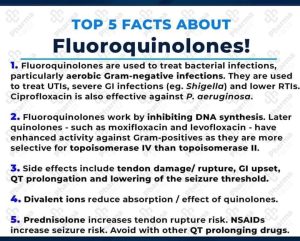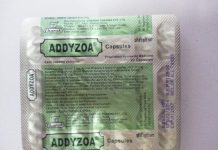Fluoroquinolones: Examples, Indications, Side Effects, Drug Interactions.
EXAMPLES
🔸 ciprofloxacin
🔹 ofloxacin
🔸 levofloxacin
🔹 gatifloxacin
🔸 norfloxacin
🔹 gemifloxacin
🔸 nalidixic acid
🔹 moxifloxacin
🔸 delafloxacin
INDICATIONS
👉 urinary tract infections, cystitis
👉 GI infections eg. with Shigella, Campylobacter
👉 lower RTIs; pneumonia
👉 Pseudomonas aeruginosa infection
👉 gonorrhea
MECHANISM OF ACTION
Fluoroquinolones kill bacteria by inhibiting DNA synthesis.
Fluoroquinolones inhibit the ligase activity of:
🧬 type II topoisomerases
🧬 DNA gyrase
🧬 topoisomerase IV
With ligase activity disrupted, these enzymes release DNA with single- and double-strand breaks that lead to cell death.

They are particularly active against aerobic Gram-negative bacteria, which explains their use in urinary and GI infections etc. Some fluoroquinolones – such as moxifloxacin and levofloxacin – have enhanced activity against Gram-positive organisms.
SIDE EFFECTS
◾️ GI upset – nausea, diarrhea, vomiting
◾️ immediate / delayed hypersensitivity reactions
◾️ they lower the seizure threshold
◾️ increase risk of tendon damage / rupture (rare)
◾️ prolong the QT interval / arrhythmia risk
◾️ increased risk of C. difficile colitis
🛑 Can cause mitochondrial damage with associated fibromyalgia, joint pains and muscle aches.
🛑 Fluoroquinolones are notorious for causing peripheral neuropathy
DRUG INTERACTIONS
☑️ multivalent ions (calcium, iron etc.) reduce the absorption and efficacy of fluoroquinolones.
☑️ NSAIDs increase the risk of seizures.
☑️ with prednisolone, tendon rupture risk increases.
☑️ arrhythmia risk increases with other drugs that prolong the QT interval (macrolides, quinine, amiodarone, SSRIs, some antipsychotics etc.).
################
A frequently requested topic: 👇
Fluoroquinolone Antibiotics and Ehlers-Danlos Syndromes
If you’ve ever wondered why people keep talking about fluoroquinolone antibiotics in the EDS community, here are some things to know:
1️⃣ FDA Warning: In 2018, the U.S. Food and Drug Administration (FDA) issued a warning about fluoroquinolones for certain patients at risk (such as those with Marfan Syndrome and EDS) and their potential to increase the occurrence of aortic rupture.
2️⃣ Connective Tissue Damage: Fluoroquinolones have been associated with connective tissue damage, leading to musculoskeletal issues such as tendon rupture, nerve damage, and spontaneous cervical artery dissection and more.
3️⃣ Long-Term Consequences: Some individuals have reported long-term health issues after taking fluoroquinolones. Some people with EDS have mentioned that their hypermobility was less symptomatic until they took these antibiotics.
It’s important to remember that fluoroquinolones are commonly prescribed and can be necessary for certain infections. However, it’s crucial for both healthcare providers and patients to be fully aware of all the risks, especially when prescribing to patients with EDS.
Being informed is key to making the best decisions for your health!
Sources:
PharmaFactz
Cort Does Science
























